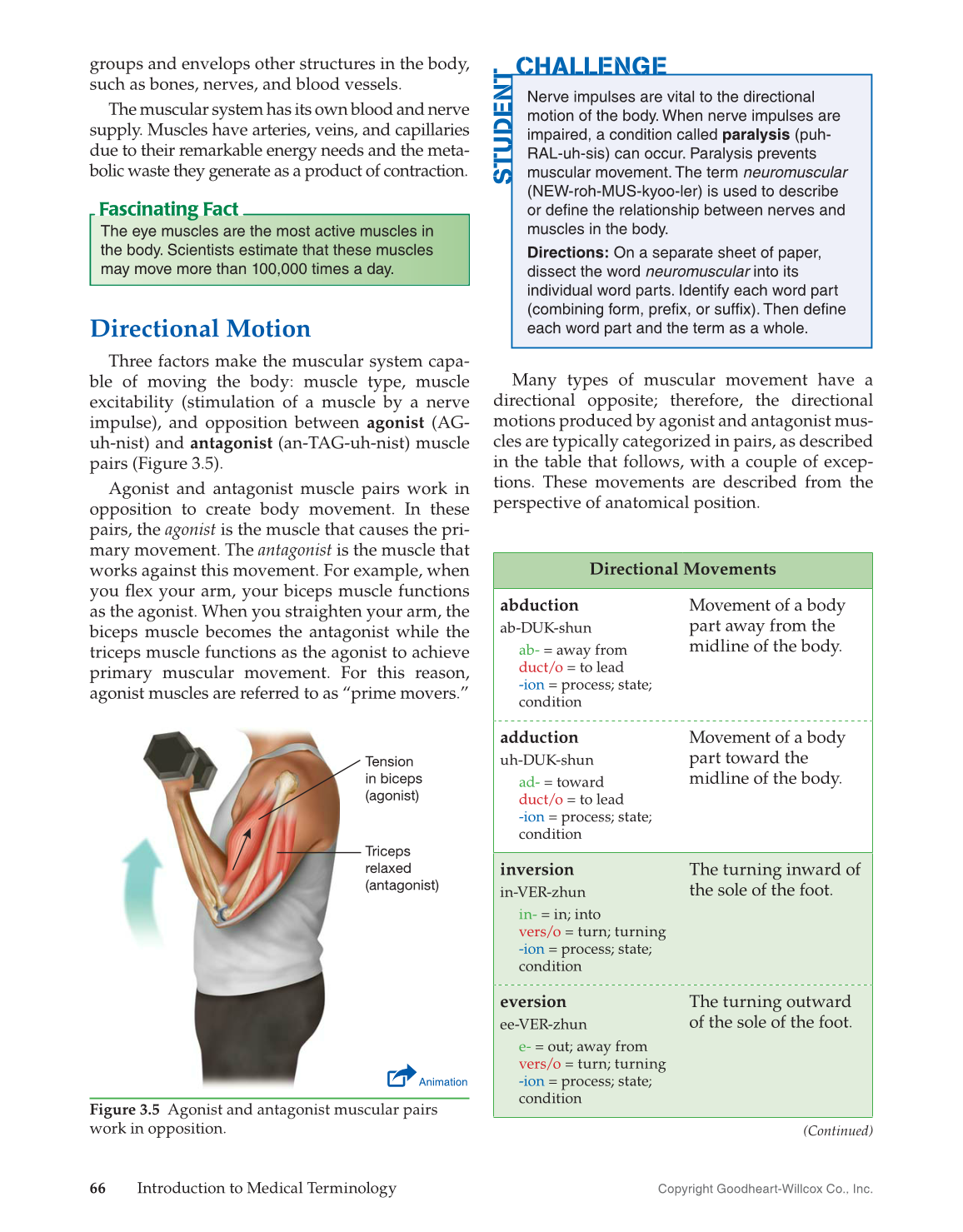66 Introduction to Medical Terminology
Copyright Goodheart-Willcox Co., Inc.
groups and envelops other structures in the body,
such as bones, nerves, and blood vessels.
The muscular system has its own blood and nerve
supply. Muscles have arteries, veins, and capillaries
due to their remarkable energy needs and the meta-
bolic waste they generate as a product of contraction.
Directional Motion
Three factors make the muscular system capa-
ble of moving the body: muscle type, muscle
excitability (stimulation of a muscle by a nerve
impulse), and opposition between agonist (AG-
uh-nist) and antagonist (an-TAG-uh-nist) muscle
pairs (Figure 3.5).
Agonist and antagonist muscle pairs work in
opposition to create body movement. In these
pairs, the agonist is the muscle that causes the pri-
mary movement. The antagonist is the muscle that
works against this movement. For example, when
you fl ex your arm, your biceps muscle functions
as the agonist. When you straighten your arm, the
biceps muscle becomes the antagonist while the
triceps muscle functions as the agonist to achieve
primary muscular movement. For this reason,
agonist muscles are referred to as “prime movers.”
The eye muscles are the most active muscles in
the body. Scientists estimate that these muscles
may move more than 100,000 times a day.
Fascinating Fact
Nerve impulses are vital to the directional
motion of the body. When nerve impulses are
impaired, a condition called paralysis (puh-
RAL-uh-sis) can occur. Paralysis prevents
muscular movement. The term neuromuscular
(NEW-roh-MUS-kyoo-ler) is used to describe
or defi ne the relationship between nerves and
muscles in the body.
Directions: On a separate sheet of paper,
dissect the word neuromuscular into its
individual word parts. Identify each word part
(combining form, prefi x, or suffi x). Then defi ne
each word part and the term as a whole.
Many types of muscular movement have a
directional opposite; therefore, the directional
motions produced by agonist and antagonist mus-
cles are typically categorized in pairs, as described
in the table that follows, with a couple of excep-
tions. These movements are described from the
perspective of anatomical position.
Directional Movements
abduction
ab-DUK-shun
ab- = away from
duct/o = to lead
-ion = process; state;
condition
Movement of a body
part away from the
midline of the body.
adduction
uh-DUK-shun
ad- = toward
duct/o = to lead
-ion = process; state;
condition
Movement of a body
part toward the
midline of the body.
inversion
in-VER-zhun
in- = in; into
vers/o = turn; turning
-ion = process; state;
condition
The turning inward of
the sole of the foot.
eversion
ee-VER-zhun
e- = out; away from
vers/o = turn; turning
-ion = process; state;
condition
The turning outward
of the sole of the foot.
Figure 3.5 Agonist and antagonist muscular pairs
work in opposition.
Triceps
relaxed
(antagonist)
Tension
in biceps
(agonist)
Animation
(Continued)
